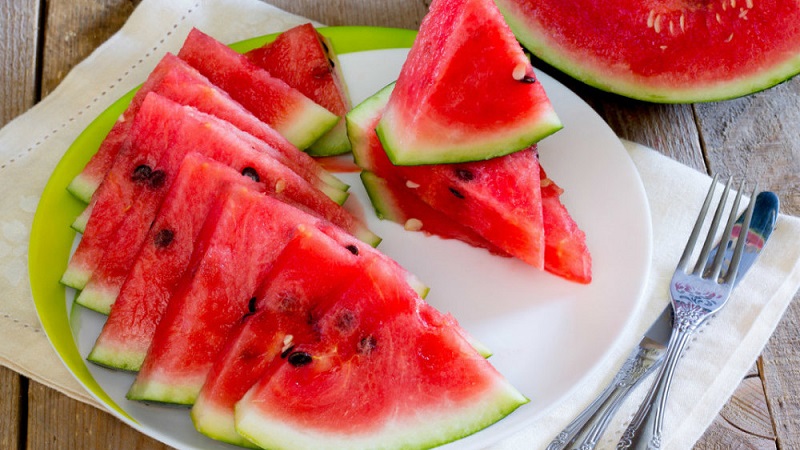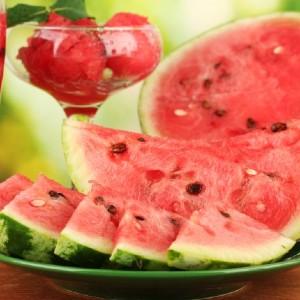Watermelon raises or lowers blood pressure: is it possible to eat it with hypertension
A regular increase in pressure leads to serious consequences: with a sharp jump in blood pressure, there is a negative effect on the kidneys, heart, and liver.
To some extent, the well-known melon culture - watermelon - helps to reduce and prevent attacks of an increase in blood pressure. Fruit pulp does not allow completely abandoning drugs, but it has a beneficial effect on the cardiovascular system, reduces high blood pressure, enhances the effect of pharmaceuticals and reduces the need for them.
The article will discuss how watermelon affects blood pressure, what are its benefits and harms in case of problems with blood pressure, how to use it correctly.
The content of the article
How does watermelon affect blood pressure?
Regular consumption of watermelon reduces and stabilizes high blood pressure, normalizes the pulse, serves as a prevention of the development of complications from the heart and blood vessels.
The edible portion (pulp and rind) contains citrulline and arginine. These are amino acids responsible for maintaining the vascular tone of the arterial bed, on which blood pressure and nutrition of all organs and tissues depend. When the body is deficient in citrulline and arginine, blood pressure rises.

Other effects of amino acids include the ability to reduce cholesterol levels, accelerate tissue regeneration, improve muscle nutrition, protect organs and tissues from the destructive effects of aggressive radicals, prevent atherosclerosis, heart ischemia, and influence other risk factors for hypertension.
Watermelon, having the properties of a diuretic and choleretic, enhances the excretion of water and sodium, reduces plasma volume, reduces vascular resistance, as a result, the pressure drops to normal levels.
For reference. Watermelon contains a lot of vegetable fiber, which, like a sponge, cleanses the blood, liver, kidneys, removes toxins and toxins, excess fluid from the body, activates intestinal motility, which in combination improves the prognosis for high blood pressure.
Does watermelon normalize, raise or lower blood pressure?
The fruit pulp of watermelon lowers high blood pressure and helps to maintain normal valuesreduces cardiovascular risks. With arterial hypotension (persistent lowering of blood pressure), it is recommended to use the melon culture with caution.
The answer to the question whether the pressure can rise again is unequivocally positive. Watermelon is not a medicine, and he cannot permanently eliminate problems with blood pressure... Features of the development and course of arterial hypertension depend on the lifestyle, age, the presence of provoking factors, timely and well-chosen treatment.
The fruit pulp of a watermelon serves as a good prophylactic agent against high blood pressure, but without concomitant treatment and rehabilitation measures, it is not able to dramatically affect the outcome of the disease.

Can you eat watermelon with high or low blood pressure?
Is it possible to eat watermelon with increased pressure? Yes, it is used to quickly lower and stabilize blood pressure... The product has a diuretic, fortifying, antioxidant effect on the body, removes protein waste, regulates the tone of the vascular bed.
There is no definite answer to the question of whether it is possible to eat a watermelon under reduced pressure... It all depends on individual performance. Fruit pulp has diuretic properties, due to which it is included in the list of prohibited products during a period of persistent decrease in blood pressure.
However other properties of watermelon confirm its usefulness in hypotension:
- lycopene improves the functioning of the cardiovascular system;
- replenishes the lack of iron in the body, increases the synthesis of erythrocytes, as a result, the severity of symptoms of hypotension (headache, dizziness) decreases, and blood pressure returns to normal;
- improves the condition of the walls of blood vessels, increases their elasticity, supplies the body with potassium and magnesium, which contribute to the full-fledged conducting work of the heart.
Given the ability of watermelon to reduce high blood pressure, it is necessary to use fruit pulp with arterial hypotension in a limited amount, observing the reaction of the body.
It is interesting:
Is it possible to eat watermelon on an empty stomach
The benefits of watermelon for problems with blood pressure
Watermelon has a positive effect on the heart and blood vessels... It has a choleretic effect, which eliminates edema, cleanses the blood of harmful toxins and toxins, reduces the load on the heart, and eliminates signs of stagnation of blood circulation.

Citrulline and arginine have a pronounced effect on blood vessels, raise the concentration of nitric oxide in the blood, reduce blood flow to the heart.
For reference. With regular use of watermelon, the risk of atherosclerosis, ischemia, and myocardial infarction is minimized.
Potential harm
Watermelon has the ability to accumulate nitrates in the fruit pulpthat are toxic to the body. When an excessive amount of toxins enter the digestive tract, vomiting, nausea, dizziness, chills, painful spasm in the stomach appear. Due to the abundant loss of fluid during diarrhea, vomiting, the water-electrolyte balance is disturbed, the body experiences dehydration.
therefore it is better to use fruits grown on your own plot... If you buy berries at the market or in the store, it is important to choose a natural product.
Watermelon can be harmful to healthif there is an individual intolerance to one or more components of the composition. An allergic reaction manifests itself in the form of a rash, itching, flaking and redness on the skin, in the worst case, swelling of mucous membranes and soft tissues occurs.
Norms and rules of consumption
 Even in a healthy person, excessive consumption of berries can negatively affect on the functionality of the kidneys, as too much water enters the body. To maintain the therapeutic effect, an average adult needs to eat 1-2 kg of fruit pulp, provided there are no contraindications, but not more than 2.5 kg per day.
Even in a healthy person, excessive consumption of berries can negatively affect on the functionality of the kidneys, as too much water enters the body. To maintain the therapeutic effect, an average adult needs to eat 1-2 kg of fruit pulp, provided there are no contraindications, but not more than 2.5 kg per day.
Fresh watermelon pulp is consumed in season, as an independent dessert, is added to fruit salads, processed into juice. You can not eat a berry with dairy products, bakery products, wash it down with water, tea, alcohol. It is not recommended to consume watermelon in the morning on an empty stomach, as the composition contains acids that irritate the mucous membrane and can provoke nausea, pain in the stomach, heartburn.
The use of watermelon peels for hypertension
Watermelon rinds help stabilize high blood pressure... They are harvested from mid-August to late September and are usually consumed in winter. They contain a complex of minerals, B vitamins, amino acids, arginine and citrulline, on which blood pressure depends.
Traditional medicine recipes
Dried rinds are delicious.resemble candied fruits.
Recipe:
 Wash the watermelon well with soapy water, blot with a paper towel to remove any remaining moisture.
Wash the watermelon well with soapy water, blot with a paper towel to remove any remaining moisture.- Cut into portions, remove the pulp. Further, in the recipe, use a dense white part of the crust, peeled from the green peel.
- Cut the crusts into slices. If you are unsure about the quality of the watermelon, it is best to soak the rind in cold water for several hours to remove toxins from the composition.
- Use a colander to get rid of excess liquid.
- Cover the baking sheet with parchment paper, lay out the watermelon peels. Cook in a preheated oven at 55-60 ° C until they are light and brittle.
The cooled watermelon rind is ready to eat... You can grind them into powder with a blender and take 1 tsp. 3 times a day. The course of treatment is 30 days. Improvements will be noticeable after the first week: weakness, dizziness and headache will disappear, endurance and performance will increase.
An infusion is prepared from dried peels, which reduces pressure... To do this, pour 80 g of crusts with 500 ml of boiling water, insist under a lid for 2-3 hours. The cooled infusion should be taken in 100 ml at intervals of 5-6 times a day.
Contraindications
Watermelon is contraindicated in case of individual intolerance product. It is necessary to limit the use of fruit pulp for people with gastrointestinal diseases in the acute stage - with gastritis with high acidity, gastric ulcer and duodenal ulcer.
Use the berry with caution and in limited quantities in the presence of large stones in the kidneys, bladder, other parts of the urinary system. Possessing a diuretic effect, watermelon can provoke the movement of stones, which is manifested by painful sensations and threatens with disruption of urodynamics, changes in renal functions.
Take a note:
Tips & Tricks
To get the most out of watermelon it is important to choose natural fruits without harm to the body. You should not buy melons before August, since this time is considered the biological period of their ripening in nature. Early varieties contain nitrates, which accelerate the ripening process.

The quality of a watermelon can be determined by external signs.... A high-quality watermelon weighs 5-10 kg, it is large, but not heavy, has a small yellow earthen spot on the side, a pronounced striped pattern, a matte finish without a glossy sheen, a dry stalk. When tapped with a hand, it emits a booming sound, springs when compressed, without traces of damage, cuts, with a dense skin.
After cutting, pay attention to the pulp... If it is deep purple in color with yellow veins, ideally smooth and even, then it contains nitrates. In a good watermelon, the pulp has grains, it is red with white veins.
As for the rules and regulations for the use of watermelon with hypertension and the question of whether it is possible to use melons and gourds with increased pressure, this should be discussed with the attending physician. The specialist must exclude possible contraindications, determine the ways of using fruit pulp and peels in a particular case, prescribe adequate drug treatment.
If, after drinking watermelon, the general state of health has worsened, there is vomiting, nausea, stomach pain, cramping, stop drinking watermelon immediately. If symptoms persist or worsen, seek immediate medical attention.
Conclusion
Watermelon is a natural source of arginine and citrulline, which are essential for normalizing vascular tone and stabilizing blood pressure.
The pulp and crusts of melons have a diuretic effect, remove slags and toxins from the body, lower cholesterol levels, activate intestinal motility, which becomes the key to a successful prognosis for recovery in people with arterial hypertension.